2015 VOLKSWAGEN POLO Air con
[x] Cancel search: Air conPage 2 of 100
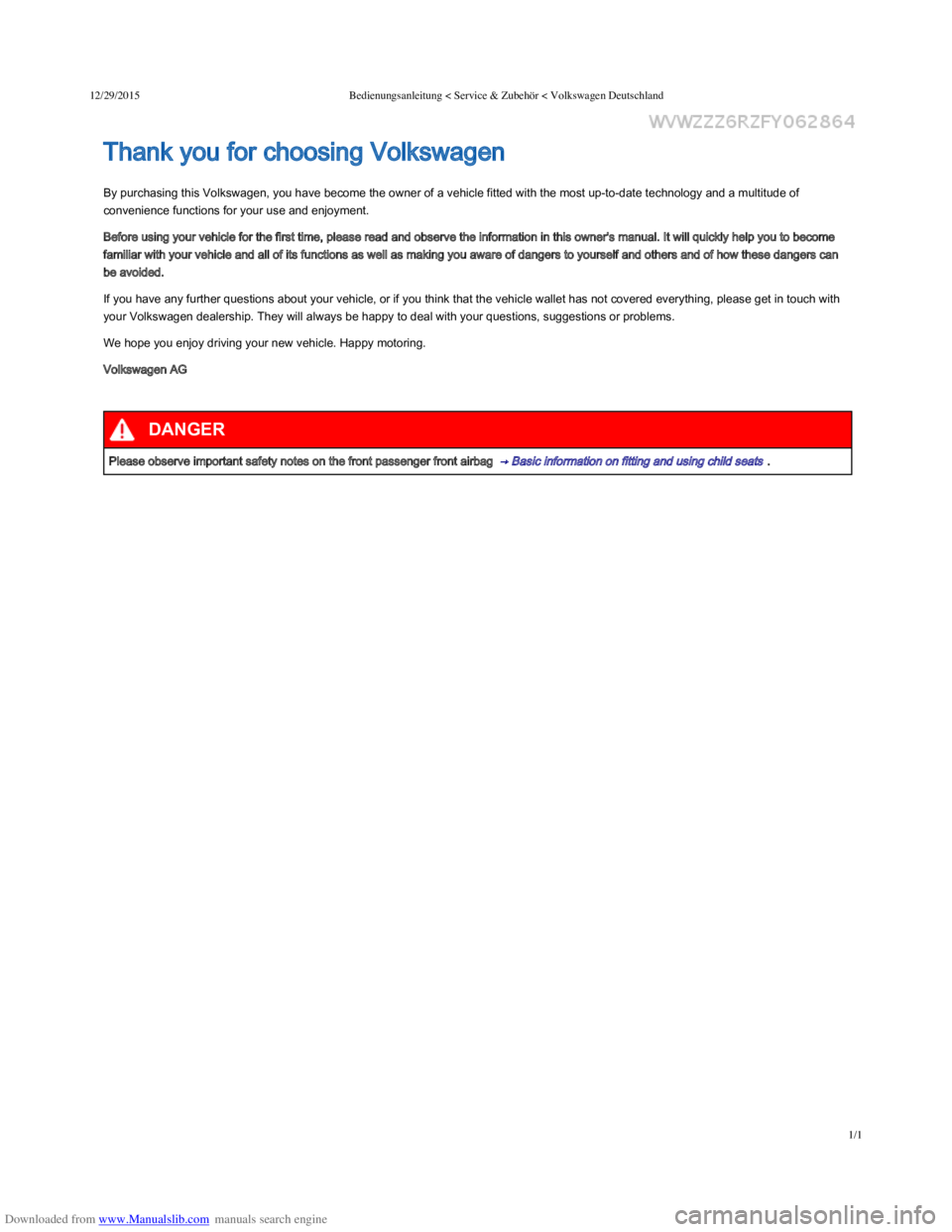
Downloaded from www.Manualslib.com manuals search engine 12/29/2015Bedienungsanleitung < Service & Zubehör < Volkswagen Deutschland
1/1
By purchasing this Volkswagen, you have become the owner of a vehicle fitted with the most up-to-date technology and a multitude of
convenience functions for your use and enjoyment.
Before using your vehicle for the first time, please read and observe the information in this owner's manual. It will quickly help you to become
familiar with your vehicle and all of its functions as well as making you aware of dangers to yourself and others and of how these dangers can
be avoided.
If you have any further questions about your vehicle, or if you think that the vehicle wallet has not covered everything, please get in touch with
your Volkswagen dealership. They will always be happy to deal with your questions, suggestions or problems.
We hope you enjoy driving your new vehicle. Happy motoring.
Volkswagen AG
Thank you for choosing Volkswagen
Please observe important safety notes on the front passenger front airbag → Basic information on fitting and using child seats .
DANGER
Page 10 of 100

Downloaded from www.Manualslib.com manuals search engine 12/29/2015Bedienungsanleitung < Service & Zubehör < Volkswagen Deutschland
7/32
- Buttons for operating the Adaptive Cruise Control (ACC) , , , – – → Adaptive Cruise
Control (ACC)
- Volume setting for the radio, navigation announcements or a telephone conversation –
- Buttons for operating the Volkswagen information system – – , ,
- Opening the main telephone menu or accepting a telephone call
- Activating voice commands
- Audio, navigation –
Horn (works only when the ignition is switched on)
Ignition lock → Starting and stopping the engine
Pedals → Changing gear
Fuse box cover → Fuses
Driver front airbag → Airbag system
Lever for adjusting the steering column → Adjusting the seat position
Upper section of the centre console
Fig. 7 Overview of the upper section of the centre console
Key to → Fig. 7 :
Vent – – → Heating, ventilating, cooling
Overview of the centre console
Page 11 of 100
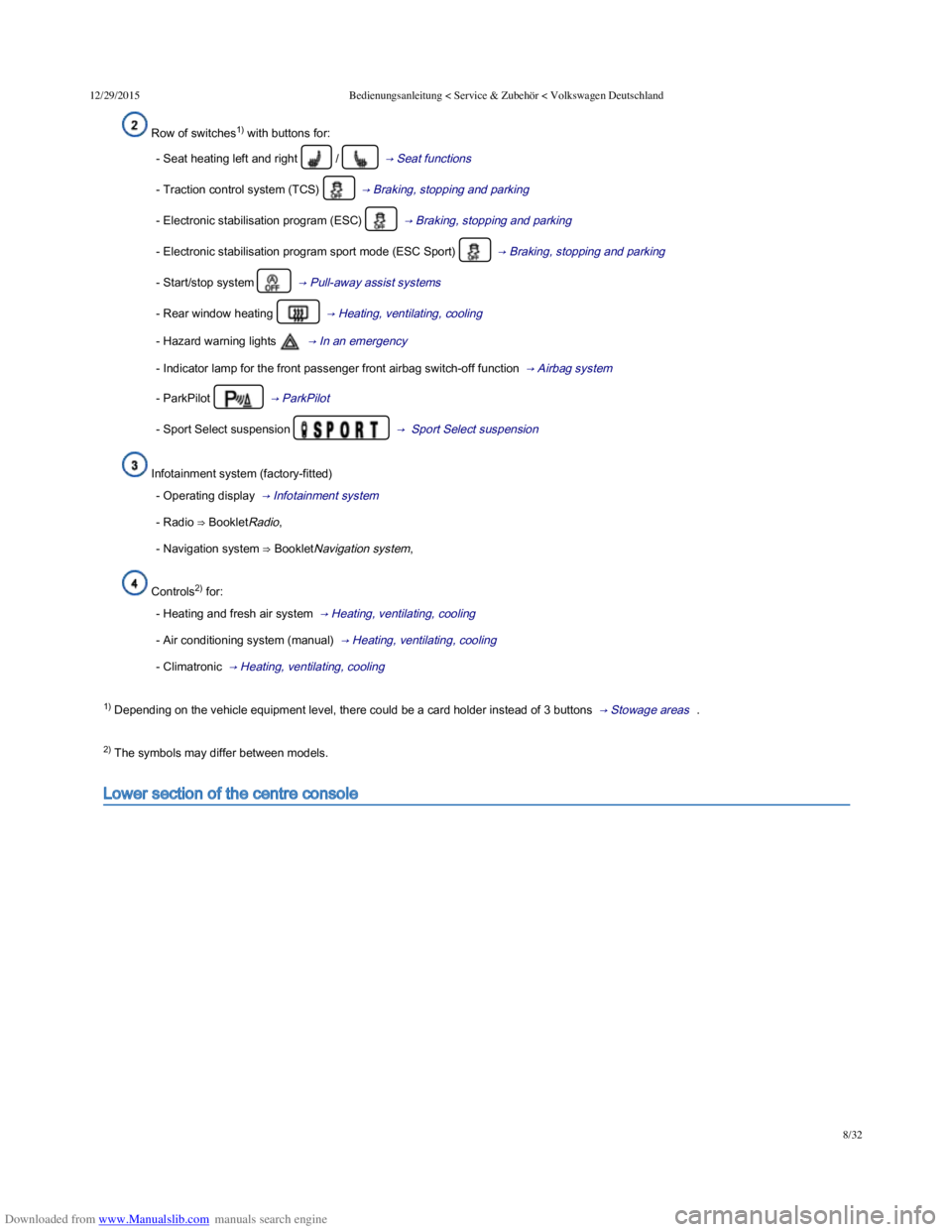
Downloaded from www.Manualslib.com manuals search engine 12/29/2015Bedienungsanleitung < Service & Zubehör < Volkswagen Deutschland
8/32
Row of switches1) with buttons for:
- Seat heating left and right / → Seat functions
- Traction control system (TCS) → Braking, stopping and parking
- Electronic stabilisation program (ESC) → Braking, stopping and parking
- Electronic stabilisation program sport mode (ESC Sport) → Braking, stopping and parking
- Start/stop system → Pull-away assist systems
- Rear window heating → Heating, ventilating, cooling
- Hazard warning lights → In an emergency
- Indicator lamp for the front passenger front airbag switch-off function → Airbag system
- ParkPilot → ParkPilot
- Sport Select suspension → Sport Select suspension
Infotainment system (factory-fitted)
- Operating display → Infotainment system
- Radio ⇒ BookletRadio,
- Navigation system ⇒ BookletNavigation system,
Controls2) for:
- Heating and fresh air system → Heating, ventilating, cooling
- Air conditioning system (manual) → Heating, ventilating, cooling
- Climatronic → Heating, ventilating, cooling
1) Depending on the vehicle equipment level, there could be a card holder instead of 3 buttons → Stowage areas .
2) The symbols may differ between models.
Lower section of the centre console
Page 13 of 100
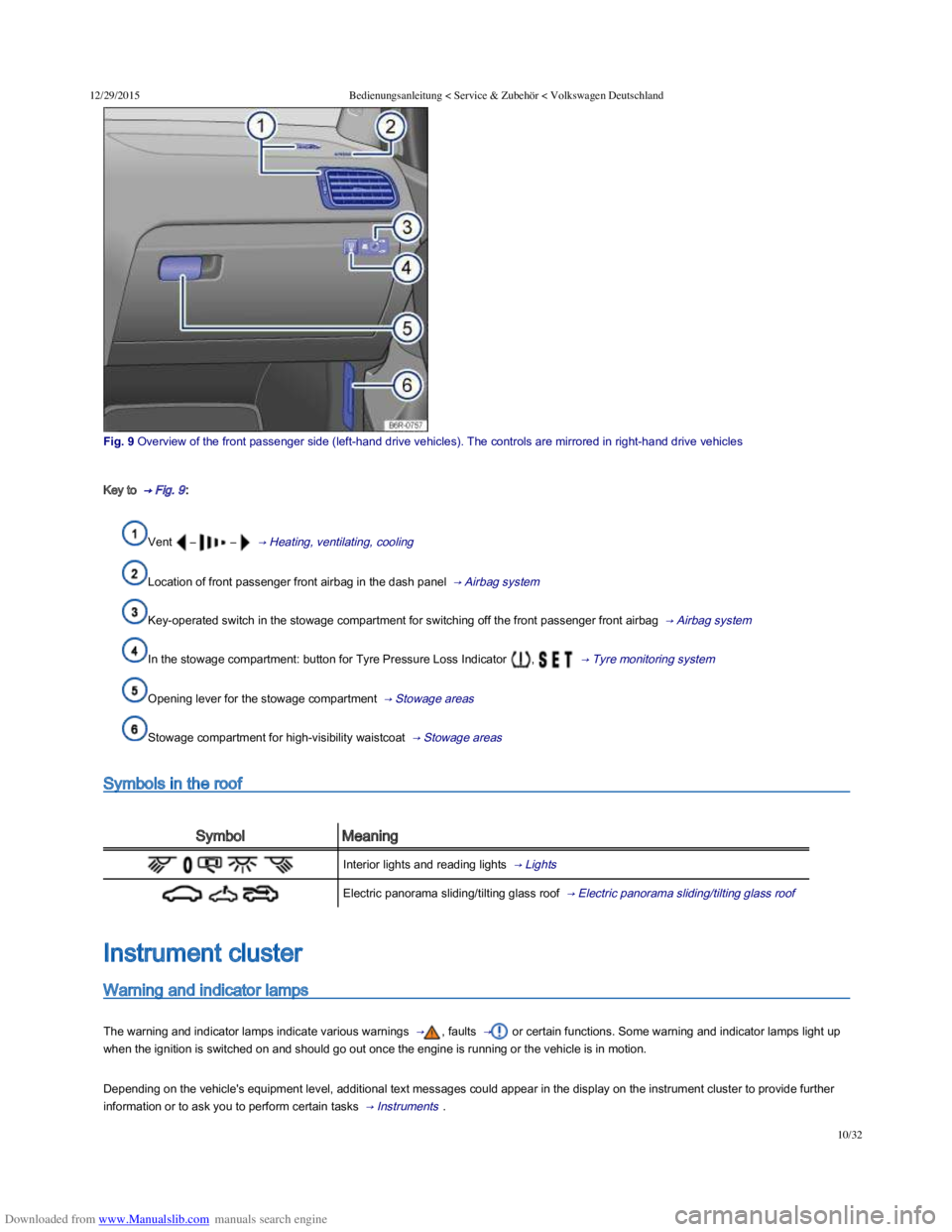
Downloaded from www.Manualslib.com manuals search engine 12/29/2015Bedienungsanleitung < Service & Zubehör < Volkswagen Deutschland
10/32
Fig. 9 Overview of the front passenger side (lefthand drive vehicles). The controls are mirrored in righthand drive vehicles
Key to → Fig. 9 :
Vent – – → Heating, ventilating, cooling
Location of front passenger front airbag in the dash panel → Airbag system
Key-operated switch in the stowage compartment for switching off the front passenger front airbag → Airbag system
In the stowage compartment: button for Tyre Pressure Loss Indicator , → Tyre monitoring system
Opening lever for the stowage compartment → Stowage areas
Stowage compartment for high-visibility waistcoat → Stowage areas
Symbols in the roof
SymbolMeaning
Interior lights and reading lights → Lights
Electric panorama sliding/tilting glass roof → Electric panorama sliding/tilting glass roof
Warning and indicator lamps
The warning and indicator lamps indicate various warnings → , faults → or certain functions. Some warning and indicator lamps light up
when the ignition is switched on and should go out once the engine is running or the vehicle is in motion.
Depending on the vehicle's equipment level, additional text messages could appear in the display on the instrument cluster to provide further
information or to ask you to perform certain tasks → Instruments .
Instrument cluster
Page 15 of 100
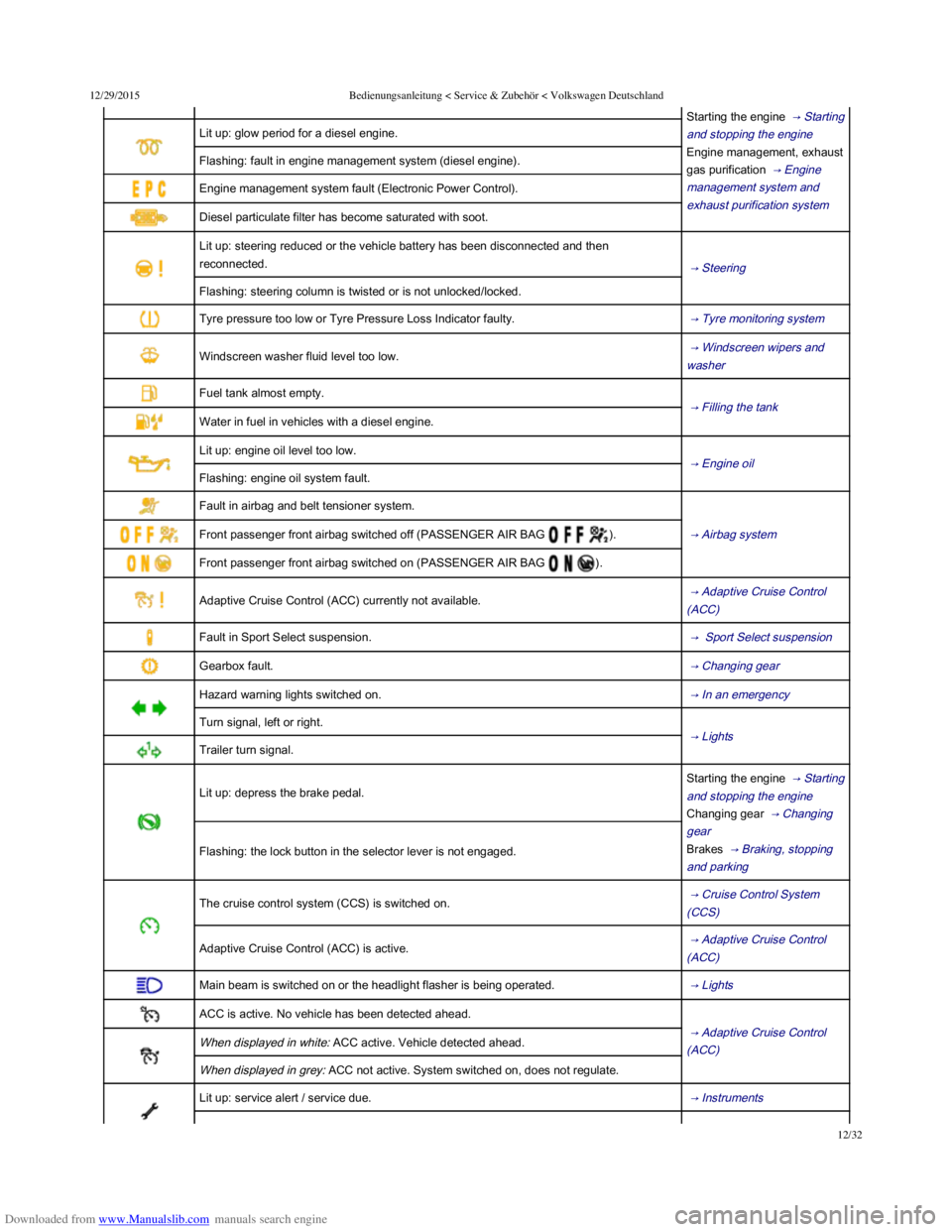
Downloaded from www.Manualslib.com manuals search engine 12/29/2015Bedienungsanleitung < Service & Zubehör < Volkswagen Deutschland
12/32
Starting the engine → Starting
and stopping the engine
Engine management, exhaust
gas purification → Engine
management system and
exhaust purification system
Lit up: glow period for a diesel engine.
Flashing: fault in engine management system (diesel engine).
Engine management system fault (Electronic Power Control).
Diesel particulate filter has become saturated with soot.
Lit up: steering reduced or the vehicle battery has been disconnected and then
reconnected. → Steering
Flashing: steering column is twisted or is not unlocked/locked.
Tyre pressure too low or Tyre Pressure Loss Indicator faulty. → Tyre monitoring system
Windscreen washer fluid level too low. → Windscreen wipers and
washer
Fuel tank almost empty.
→ Filling the tank
Water in fuel in vehicles with a diesel engine.
Lit up: engine oil level too low.
→ Engine oil
Flashing: engine oil system fault.
Fault in airbag and belt tensioner system.
→ Airbag system Front passenger front airbag switched off (PASSENGER AIR BAG ).
Front passenger front airbag switched on (PASSENGER AIR BAG ).
Adaptive Cruise Control (ACC) currently not available. → Adaptive Cruise Control
(ACC)
Fault in Sport Select suspension. → Sport Select suspension
Gearbox fault. → Changing gear
Hazard warning lights switched on. → In an emergency
Turn signal, left or right.
→ Lights
Trailer turn signal.
Lit up: depress the brake pedal.
Starting the engine → Starting
and stopping the engine
Changing gear → Changing
gear
Brakes → Braking, stopping
and parking
Flashing: the lock button in the selector lever is not engaged.
The cruise control system (CCS) is switched on. → Cruise Control System
(CCS)
Adaptive Cruise Control (ACC) is active. → Adaptive Cruise Control
(ACC)
Main beam is switched on or the headlight flasher is being operated. → Lights
ACC is active. No vehicle has been detected ahead.
→ Adaptive Cruise Control
(ACC) When displayed in white: ACC active. Vehicle detected ahead.
When displayed in grey: ACC not active. System switched on, does not regulate.
Lit up: service alert / service due. → Instruments
→ Changing gear
Page 36 of 100
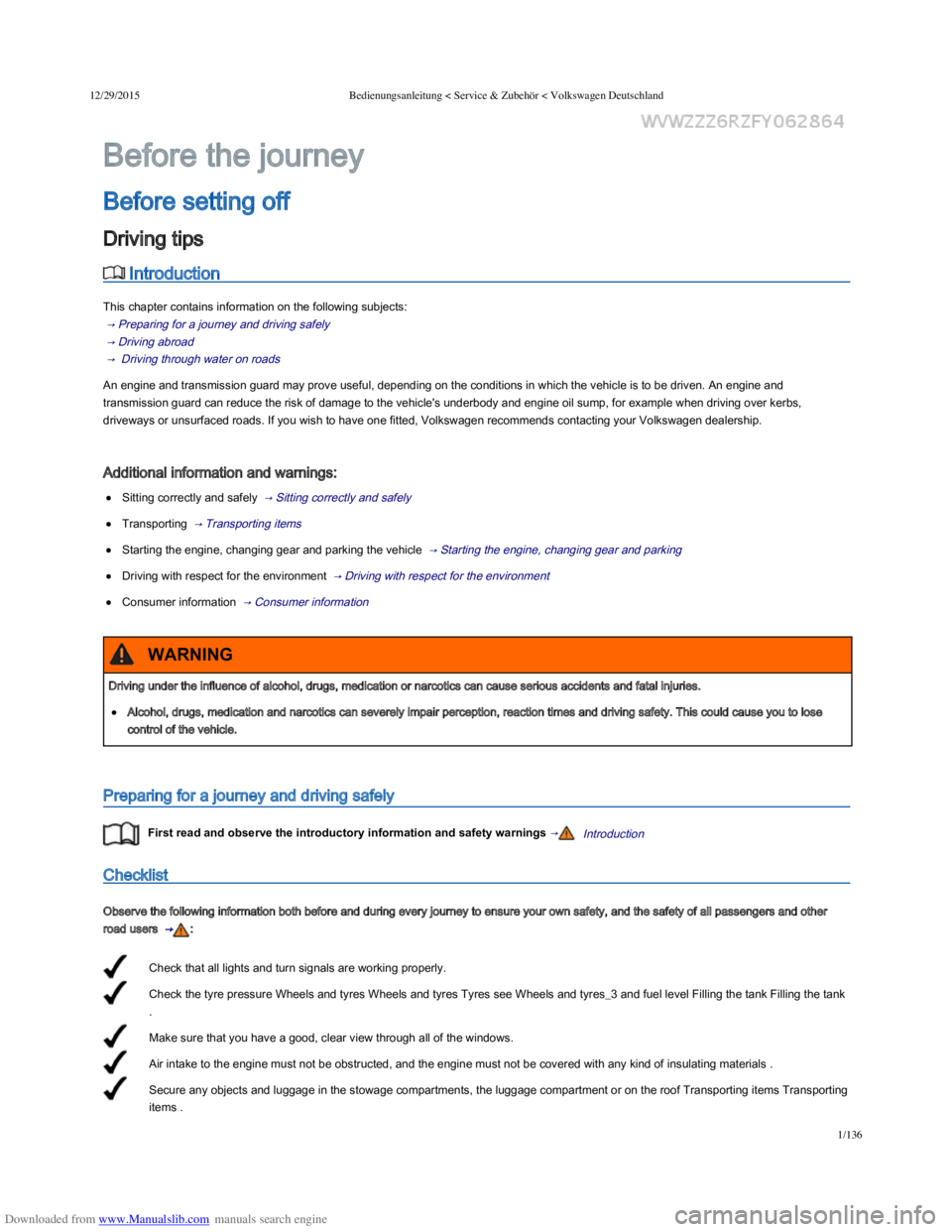
Downloaded from www.Manualslib.com manuals search engine 12/29/2015Bedienungsanleitung < Service & Zubehör < Volkswagen Deutschland
1/136
Check that all lights and turn signals are working properly.
Check the tyre pressure Wheels and tyres Wheels and tyres Tyres see Wheels and tyres_3 and fuel level Filling the tank Filling the tank
.
Make sure that you have a good, clear view through all of the windows.
Air intake to the engine must not be obstructed, and the engine must not be covered with any kind of insulating materials .
Secure any objects and luggage in the stowage compartments, the luggage compartment or on the roof Transporting items Transporting
items .
Introduction
This chapter contains information on the following subjects:
→ Preparing for a journey and driving safely
→ Driving abroad
→ Driving through water on roads
An engine and transmission guard may prove useful, depending on the conditions in which the vehicle is to be driven. An engine and
transmission guard can reduce the risk of damage to the vehicle's underbody and engine oil sump, for example when driving over kerbs,
driveways or unsurfaced roads. If you wish to have one fitted, Volkswagen recommends contacting your Volkswagen dealership.
Additional information and warnings:
Sitting correctly and safely → Sitting correctly and safely
Transporting → Transporting items
Starting the engine, changing gear and parking the vehicle → Starting the engine, changing gear and parking
Driving with respect for the environment → Driving with respect for the environment
Consumer information → Consumer information
Preparing for a journey and driving safely
First read and observe the introductory information and safety warnings →Introduction
Checklist
Observe the following information both before and during every journey to ensure your own safety, and the safety of all passengers and other
road users → :
Before the journey
Before setting off
Driving tips
Driving under the influence of alcohol, drugs, medication or narcotics can cause serious accidents and fatal injuries.
Alcohol, drugs, medication and narcotics can severely impair perception, reaction times and driving safety. This could cause you to lose
control of the vehicle.
WARNING
Page 37 of 100

Downloaded from www.Manualslib.com manuals search engine 12/29/2015Bedienungsanleitung < Service & Zubehör < Volkswagen Deutschland
2/136
Make sure that you are able to operate the pedals freely at all times.
Secure any children travelling in the vehicle in a restraint system suitable for their weight and size Child seats Child seat ISOFIX see
Child seat Top tether see Child seat .
Adjust the front seats, head restraints and mirrors properly in accordance with the size of the occupants Adjusting the seat position
Sitting .
Wear shoes that provide good grip for your feet when using the pedals.
The floor mat in the footwell on the driver side must leave the pedal area free and must be securely fastened.
Assume a correct sitting position before setting off and maintain this position while driving. This also applies to all passengers Adjusting
the seat position Sitting .
Fasten your seat belt correctly before setting off and keep it properly fastened throughout the journey. This also applies to all
passengers Seat belts Seat belts .
Each vehicle occupant must sit in a seat of their own and must have their own seat belt.
Never drive if your driving ability is impaired, e.g. by medication, alcohol or drugs.
Do not allow yourself to be distracted from the traffic, e.g. by passengers, telephone calls, opening menus and making adjustments to
settings.
Always adapt your speed and driving style to suit visibility, weather, road and traffic conditions.
Observe traffic regulations and speed limits.
When travelling long distances, stop and take a break regularly – at least every 2 hours.
Secure animals in the vehicle using a system that is suitable for their weight and size.
Does the vehicle need any technical modifications for driving abroad, e.g. masking or switching the headlights over?
Are the necessary tools, diagnostic equipment and spare parts available for service and repair work?
Are there any Volkswagen dealerships in the destination country?
For petrol engines: is unleaded petrol with the correct octane number available?
Regular servicing of your vehicle not only maintains its value, it also ensures that your vehicle remains roadworthy and in working order.
Servicing work should therefore be carried out in accordance with the service schedule. Some work may have to be carried out before the due
date of the next service if the vehicle is subjected to severe operating conditions. Severe operating conditions are, for example, frequent stop and
go driving, frequent driving with a trailer and driving in areas with high levels of dust. Further information can be obtained from your Volkswagen
dealership or qualified workshop.
Driving abroad
First read and observe the introductory information and safety warnings →Introduction
Checklist
In some countries, special safety standards and emissions-related legislation apply that may differ form the construction of the vehicle,
Volkswagen recommends that you visit your Volkswagen dealership before travelling abroad to find out about any legal requirements and the
following issues at your destination:
Always observe current traffic regulations and speed limits, and think ahead when driving. Correct interpretation of a driving situation can make
the difference between reaching your destination safely and having an accident with serious injuries.
WARNING
Page 49 of 100
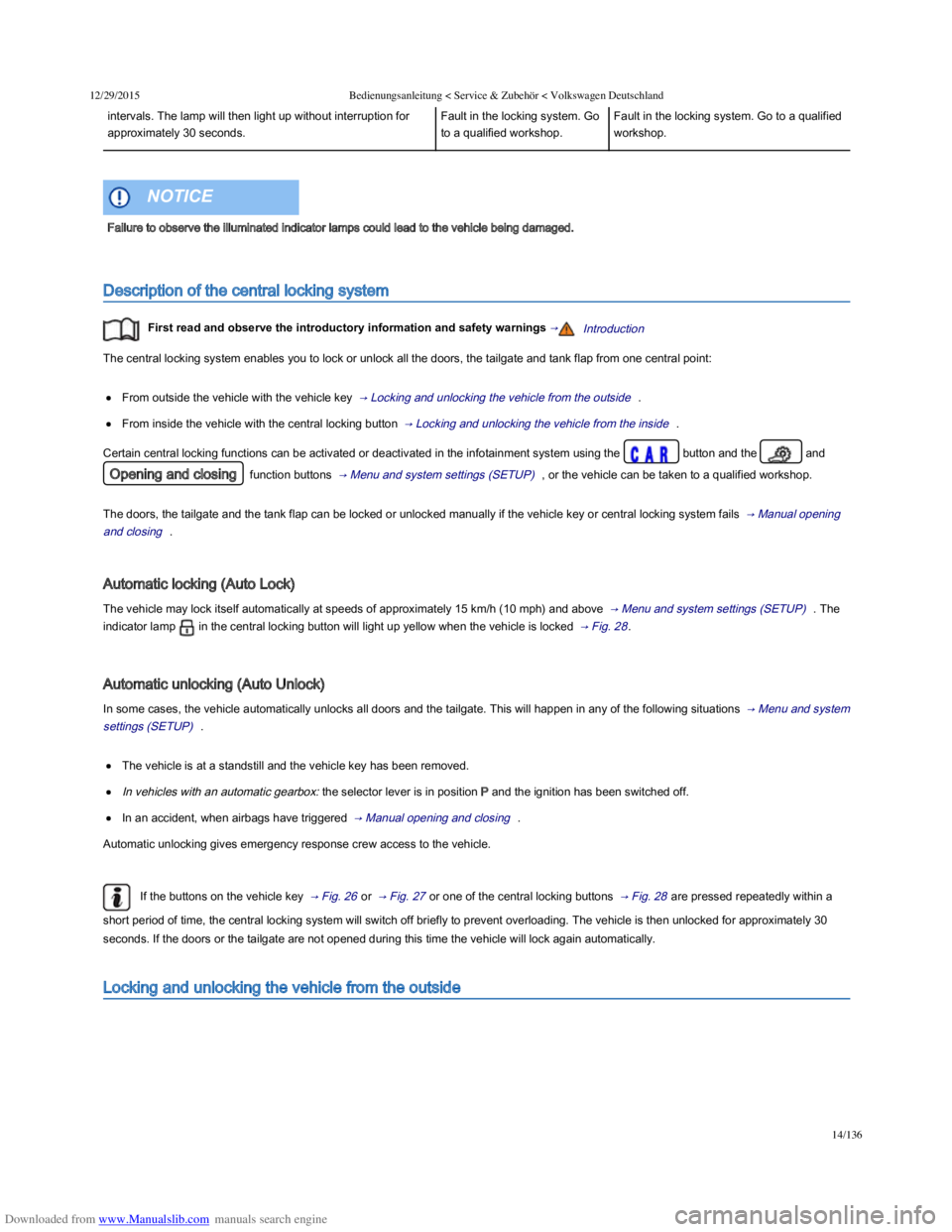
Downloaded from www.Manualslib.com manuals search engine 12/29/2015Bedienungsanleitung < Service & Zubehör < Volkswagen Deutschland
14/136
intervals. The lamp will then light up without interruption for
approximately 30 seconds.
Fault in the locking system. Go
to a qualified workshop.
Fault in the locking system. Go to a qualified
workshop.
Description of the central locking system
First read and observe the introductory information and safety warnings →Introduction
The central locking system enables you to lock or unlock all the doors, the tailgate and tank flap from one central point:
From outside the vehicle with the vehicle key → Locking and unlocking the vehicle from the outside .
From inside the vehicle with the central locking button → Locking and unlocking the vehicle from the inside .
Certain central locking functions can be activated or deactivated in the infotainment system using the button and the and
Opening and closing function buttons → Menu and system settings (SETUP) , or the vehicle can be taken to a qualified workshop.
The doors, the tailgate and the tank flap can be locked or unlocked manually if the vehicle key or central locking system fails → Manual opening
and closing .
Automatic locking (Auto Lock)
The vehicle may lock itself automatically at speeds of approximately 15 km/h (10 mph) and above → Menu and system settings (SETUP) . The
indicator lamp in the central locking button will light up yellow when the vehicle is locked → Fig. 28 .
Automatic unlocking (Auto Unlock)
In some cases, the vehicle automatically unlocks all doors and the tailgate. This will happen in any of the following situations → Menu and system
settings (SETUP) .
The vehicle is at a standstill and the vehicle key has been removed.
In vehicles with an automatic gearbox: the selector lever is in position P and the ignition has been switched off.
In an accident, when airbags have triggered → Manual opening and closing .
Automatic unlocking gives emergency response crew access to the vehicle.
If the buttons on the vehicle key → Fig. 26 or → Fig. 27 or one of the central locking buttons → Fig. 28 are pressed repeatedly within a
short period of time, the central locking system will switch off briefly to prevent overloading. The vehicle is then unlocked for approximately 30
seconds. If the doors or the tailgate are not opened during this time the vehicle will lock again automatically.
Locking and unlocking the vehicle from the outside
Failure to observe the illuminated indicator lamps could lead to the vehicle being damaged.
NOTICE